The biggest science experiment in the world - The Large Hadron Collider at CERN, will start on September 10th. So this week we peer inside a proton and discover how the LHC works to help scientists in the search for antimatter and the elusive 'Higgs boson'. Plus, we unlock the genetic key to a happy marriage, explore what giant clams can reveal about our ancestors and hear why bats silence themselves to avoid traffic jams. Plus, in Kitchen Science, Ben and Dave get dizzy with the science of spinning!
In this episode
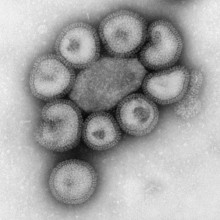
New Method to Vaccinate against the Flu
New approach to battling flu - Scientists have developed a new class of flu vaccines that might help to contain a future pandemic. Writing in this weeks PNAS New York-based researcher David Ho and his team have used DNA coding for part of the surface coat of flu viruses to protect mice against a lethal dose of the infection. Previously the best way to protect against the flu was to grow the virus in hens' eggs before chemically inactivating and purifying it to turn it into material that could safely be injected. But a major problem with this approach is that it takes a long time to produce the vaccine and, when injected, it tends to trigger a highly focused immune response against just that one form of the flu. As a result the vaccine regularly needs updating to ensure that it protects against new strains produced when the virus mutates, which it does continuously. To get around this problem the US team, who are based at Rockefeller University, first built a genetic family tree from 467 different strains of the H5N1 flu virus. This enabled them to home in on a part of the flu genome at the root of the family tree that was the same amongst the majority of the different viral strains. The team then produced a DNA sequence coding for this part of the viral genome, which was from the main surface protein called HA. Mice injected with this DNA sequence produced large amounts of antibody and white blood cells that could neutralise a range of H5N1 strains. Most encouragingly, when mice were infected with lethal doses of virus that killed control animals those previously given the new vaccine all survived. According to the researchers, their vaccine strategy offers a fast and affordable way to combat H5N1, viewed by many as the best contender to cause the next pandemic.

An Ancient Taste for Shellfish
It's a myth that if a scuba diver spies a glimmering pearl inside a giant clam and reaches in to steal it his or her arm will be grabbed by the slamming jaws of the twin-shelled mollusc. Giant clams can grow to over a metre long and they do make pearls but it is virtually impossible to get yourself trapped inside one.
But giant clams have hit the science headlines recently, with the discovery a new species living in the Red Sea. This is the first giant clam discovery in twenty years, bringing the total number of species in the world to eight, thanks to an international team of researchers led by Claudio Richter of the Alfred-Wegener-Institute for Polar and Marine Research in Germany.
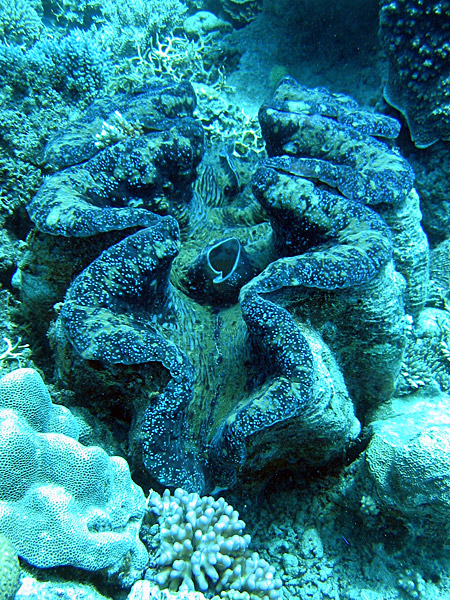 And what's more, this new clam has uncovered some of the oldest evidence yet of mankind's plundering of the oceans.
And what's more, this new clam has uncovered some of the oldest evidence yet of mankind's plundering of the oceans.
The new species, tridacna costata, is incredibly rare today, one reason why it had been overlooked for so long, but it has now been shown to be a separate species from studies of its shape and also its genetics.
Researchers have also looked back in time at the fossil record and discovered that this species used to be incredibly abundant. Around 125 thousand years ago, Tridacna costata made up around 80% of the species of giant clam living in the Red Sea. Now it makes up less than 1%.
And it seems that possible culprits for the clam's massive decline could be ancient hunter-gatherers, who may well have taking a liking to these large, nutritious shellfish, which are extremely easy to harvest because they don't run away! The timing of the demise of these giant clams coincides rather suspiciously with when it is thought early Homo sapiens began migrating out of Africa. Not just that, but the clams used to be much larger than they are today, pointing an even stronger finger of blame at mankind because is suggests that big specimens were wiped out a long time ago by our ancient ancestors.

The Genetic Key to a Happy Marriage!
Polygamy - of mice and men, or voles at least - Scientists have shown that a gene variant carried by some men could be the cause of marital dysharmony. The research builds on previous work carried out in rodents showing that prairie voles, which are highly monogamous, carry a different form of a gene called avpr1a compared with their fast and loose cousins the montane or meadow voles, which favour multiple matings. Researchers hadalso shown that adding the gene from the faithful voles to the brains of the polygamous animals could convert them into model monogamous partners.
 |
| Meadow Vole © US NPS |
Now a similar finding has emerged amongst humans. Paul Lichtenstein and his colleagues at the Karolinska institute in Sweden studied the sequence of the human version of the avpr1a gene region in 552 married or co-habiting couples and compared the sequences with measures of relationship strength. Eleven different forms of the gene region were identified but, intriguingly, one of them - allele 334 - which was carried by 40% of the participants, was strongly linked to poorer "Partner Bonding Scores" (PBS). Men with two copies of the gene (one from their father and one from their mother) were also half as likely to be married (favouring co-habitation) and twice as likely to have faced marital crisis or the threat of a divorce in the previous 12 months (34%) compared with the men with one or no copies of the 334 allele, only 16% of whom reported marriage difficulties. This suggests that what goes for the voles also goes for humans, but may also have relevance to our understanding of certain other aspects of human social behaviour and development including altruism and autism, both of which have been linked to changes in this same gene.
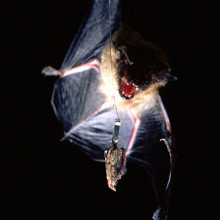
Cooperating Bats
A new study has shown that Bats might stay quiet and listen to each other when they are out hunting for their dinner.
That's according to Cynthia Moss and her colleagues from the University of Maryland in the states who have been studying big brown bats in captivity, and tracking how their ultrasonic signals changes when the group pursues their flying insect prey.
Nocturnal bats use echolocation to forage for prey and safely navigate around in the pitch dark. They emit very high pitched squeaks and measure how long it takes to bounce back to them, and from that they can work out where objects are around them.
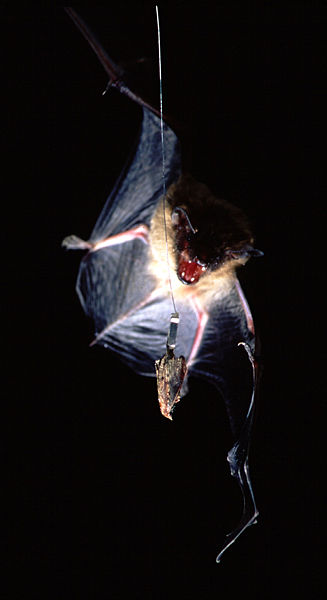 And of course most of the sounds bats make are inaudible to human ears - we can only pick up sounds of between around 20 hertz and 20 kilhertz, while bats can chirp at over 100 kilhertz.
And of course most of the sounds bats make are inaudible to human ears - we can only pick up sounds of between around 20 hertz and 20 kilhertz, while bats can chirp at over 100 kilhertz.
What Moss and her team discovered was that at certain times some of the bats turned off their sonar and went totally quiet for a while - only for around 800 milliseconds, which might not sound like much but is in fact a long time in the fast-paced life of a bat.
For now we can't be sure why the bats are going quiet like this, but it is possible that one bat stops making sounds and eavesdrops on the sounds of another bat, perhaps to help prevent crossed signals. You can imagine when they were lots of bats feeding in a similar area it would be very easy for all their signals to get mixed up and confused. If that is what the bats are doing then this would be evidence of a type of cooperation that has long been suspected but never proven in these flying mammals.
Why don't fish freeze in Antarctic water?
Helen: Wonderful question, thank you very much. The seas around Antarctica get incredibly cold. Because of the salt in it they can actually go down to -1.9 degrees centigrade. So how on Earth can things live there? In the 1980s scientists discovered that Antarctic cod or ice fish actually have antifreeze inside their blood. Since then scientists have been poking around trying to find out how it works. We're still not quite sure. It basically seems to be something to do with these things called glycopeptides. They're a protein covered in sugar which seem to stop ice crystals from growing any bigger by various ways of interacting with the water there. It also seems that the cod are able to survive with little tiny crystals in their blood. Their blood flows even if there's some little ones, as long as they don't grow any bigger they're ok. What can we do with it? It's something that it's possible we might be able to use these antifreezes for preserving donor organs. It's the idea of how do we stop things from freezing and not deteriorating whilst they are frozen? It could also be a better, more environmentally sensitive way of actually doing antifreeze for things like roads. Someone's actually started putting the genes for it inside of yeast so they can create it artificially and create lots of it. It's a possibility we might be using it. And on cars, perhaps!
What is a tingle down the spine?
Chris: I think that this is all down to mirror neurons. There's a paper in Nature Neuroscience a few weeks ago and they were looking at Olympic sportsmen. They were looking specifically at basketball players. They showed that pro basketball players (when they were watching footage of people trying to put a ball into a basket) even though they didn't show them all the footage, they just showed them the ball in the hand of the thrower and just up to the moment when they threw it. They stopped the footage and said, 'Which balls are going to go into the basket?' The pro players were able to correctly, 70% of the time, just by looking at the hand position work out whether they were going to get a basket. What they did at the same time was to measure the activity of the muscles in the subjects hands and they found that what these people were doing was superimposing what they saw as the position of the thrower's hands onto their own motor areas of their brain in order to work out and compare what that thrower was doing compared with what they would do in the same circumstances in order to work out what they thought was going to happen. This is an elegant way of showing that when we experience the world around us we superimpose what we're seeing other people doing, what we're seeing going on around us onto our own internal map of the world: these mirror neurone. These reflect the behaviour of other people, showing us what sorts of emotions they're experiencing and what they're thinking. This helps us to predict what they're going to do and therefore how to react and respond to them. When someone feels sad it makes you feel a bit sad. You feel their pain and this means that you can then put yourself in their shoes so you know how to respond appropriately. It's all about empathy. I think that probably what Gary's feeling is the effect of his mirror neurons. Pretty much all bits of the brain have these neurons, especially the bits of the brain that sense anxiety, fear, disgust and maybe even motor and visual things. Helen: A little part of us also wins those gold medals.

23:51 - What is the LHC?
What is the LHC?
with Ben Allanach from the University of Cambridge
Chris - What is the LHC all about?
Ben - the LHC is a gigantic experiment. It's the biggest experiment that's ever been staged. We're going to collide protons together and try and find out about the early universe and particles.
Chris - When you say find out about the early universe, why do we need to find out about that? What's different then that's not around today?
Ben - There were particles around we think that have since decayed very quickly. They were produced in the early universe and have decayed away now. We'd like to produce them and study them.
Chris - Specifically, what are these particles?
Ben - There are actually various things we'd like to see. One example is the famous Higgs boson. That's the one that's responsible for fundamental particles getting mass. The theories will tell you that the particles have to be massless and, of course, we know that's not the case. The Higgs boson is the missing piece of the puzzle that would explain why the other particles have mass.
Chris - Well, let's just drill down into what we mean by fundamental particles and what's inside atoms and things. Working outwards-inwards. We had an atom and this has got a nucleus, protons and neutrons and electrons round the outside. Take me from there, further inside.
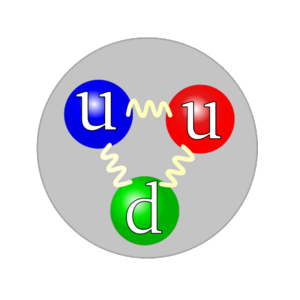 |
| Quarks in a proton © Arpad Horvath. |
Ben - We have this atom so let's go down into the centre of this positive core. That's made of protons and neutrons. They have structure within them as well. If you zoom down you can see three little point-like type things in the protons and neutrons. They're called quarks. They're kind of held together by some strong sticky quantum force that's holding them together.
Chris - We don't actually know what that force is, presumably?
Ben - We know quite a lot about it. It's a strong nuclear force and, in fact, by blowing them apart you can tell quite a lot about what that thing is.
Chris - How do we know those quarks are the simplest, smallest things? How do we know they're not things that make up the quarks themselves?
Ben - We don't. All we know is that they look simple down to 10-15m. That's a billionth, less than a billionth of a millimetre. You can't see any smaller dots at that scale in those but you can't say for sure. If you have an even bigger microscope than the LHC you will see substructure. That's one of the things we want to check.
Chris - Although the LHC is effectively an atom smasher and it's creating an enormous amount of energy, if anything it's behaving as a microscope. You're blasting particles to pieces and this makes the components that make up these particles come out so you can see them?
Ben - That's the idea. It's a weird paradox that to see smaller things you have to build bigger and bigger machines to get to higher energies. Then you can prove things deeply.
Chris - If the LHC doesn't bear fruit does this mean we're going to have to build a bigger one or do you think this is going to basically answer the question, once and for all, what is the fundamental nature of matter?
 |
| A simulated event at of the LHC of the european particle physics institute, the CERN. This simulation depicting the decay of a Higgs particle following a collision of two protons in the CMS experiment. © CERN |
Ben - It's going to answer the question about the Higgs boson in my opinion. We already know from indirect signals and previous data roughly what mass this Higgs boson has and you can calculate that the LHC's going to have enough energy now to produce them. If the Higgs theory's wrong then there'll be something else there and that would be more exciting, actually. We'll be able to investigate that. There are other possibilities like producing dark particles of dark matter which is a bit more speculative. That would be extremely interesting too.
Chris - When you mention the work of Peter Higgs who was a scientist at Edinburgh University who came up with this notion of particle that everyone wants to see but no one has ever detected, how does that fit into the big picture? What is it? What does it do?
Ben - Particles which we imagine as little dots travelling around are actually ripples on a field that's throughout all the universe. An electron, for instance we might see as a particle. If you look at it really closely it looks like a kind of ripple in the electron sea. We have the same thing for the Higgs boson. The idea is this jelly throughout the Universe. The Universe is still hot it's runny and other particles can zip through it without noticing it. As the Universe gets bigger the jelly kinda condenses. This is the special thing about the Higgs and other particles can feel it enough to be pushed through it. Newton told us that when you have to push something along it has inertia and therefore mass. These Higgs particles and fields drag other particles and give them mass.
Chris - This would be almost like a parachute on the back of a big vehicle or something? It's almost like a drag force?
Ben - Yeah.
Chris - Is it everywhere?
Ben - Yes. All of these field exist throughout all of the universe.
Chris - So when you say you're going to create the Higgs particle in the LHC, if it's there already what are you doing?
Ben - the field, the sea is there but what you want to do is create a little ripple of it which is the particle itself. A localised wave, if you like, that is the actual particle.
Chris - You're not actually making the particle, you're just making it showing itself by disturbing the field that it normally creates?
Ben - That's absolutely right.
Chris - If it does pop up what are you actually going to see? How do you see those ripples?
Ben - This Higgs particle, if you produce it, it decays very quickly within 10-20 seconds: incredibly fast. It decays into other ordinary particles which you see around the collision point. There's all sorts of electronics built around that to track these things coming out. What you have to do is look at their energies and infer back to what happened at the interaction point. Basically, what'll happen is if you produce a Higgs boson they'll come out with half of its mass. Roughly speaking, each particle will have half its mass. You add the energies up of these two things and of course there's all sorts of things happening. Over 1000 billion events , 1000 billion collisions you should see a lot of them coming out with the same kind of energy. You have to extrapolate back to the Higgs.
Chris - What would it mean to the field of particle physics if you don't see the Higgs boson when the LHC gets up to full working capacity?
Ben - It'll mean that a lot of text books have to be re-written. It'll be extremely exciting.
Chris - And expensive, potentially! What would be another explanation? Is there another counterpoint? There's the Higgs theory, is there any other way of thinking about it?
Ben - There are some other contenders but nothing anywhere more successful. I personally believe in something like the Higgs theory. Another example is that there are two quarks that have been very tightly bound together. They can act like a Higgs even though it isn't really a fundamental particle, it still looks like it. Whatever theory you cook up it's got to behave in some way like the Higgs because there are indirect signals from the previous data.
Chris - Is that basically what you'll be working on with the people at the LHC or have you got your own suite of things that you're also interested in?
Ben - My pet theory is actually supersymmetry so this is a theory which goes one step beyond the Higgs and explains why it's so light. You don't expect it to be a billion, billion times heavier just from constant fluctuations unless something happens in the theory to keep it light. Supersymmetry's an example of something that works very well with that. It predicts lots of new particles. It can predict one of the particles as dark matter that's out there in the universe. Astrophysical observations tell us there's some weird stuff out there that we can't see and it's transparent but it has gravitational force. We might be able to produce some of those, hopefully.
Chris - Sounds a bit dodgy to be working on science that's based on science that hasn't even been proven yet but I guess that's cosmology and particle physics all-through, isn't it?
Ben - That's right and that's why we need to do the experiments to check it. This particularly is very speculative. I'd give it about a 50/50 chance.
Chris - About as promising as my next grant application!
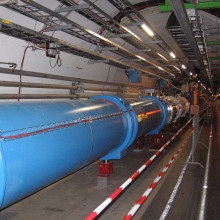
32:05 - Constructing the LHC
Constructing the LHC
with Guy Crockford
Chris - Joining us from CERN is Guy Crockford. He's one of the engineers on the project. Hello, Guy.
Guy - Hello.
Chris - Thank you for joining us. You must be very excited.
Guy - It's a very exciting time for all of us here in the control room.
Chris - What's the launch procedure building up towards Wednesday?
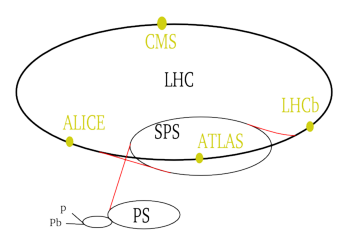 |
| The Large Hadron Collider experiments and the preaccelerators. The path of the protons (and ions) begins at linear accelerators (at p and Pb). They continues their way in the booster, in the Proton Synchrotron (PS), in the Super Proton Synchrotron (SPS) and finally they get into the 27-km-long LHC tunnel. In the LHC. © Arpad Horvath @ wikimedia |
Guy - Ok so at the moment we've reached a point where the machine is ready to take the first beams. In fact we've already made some pre-tests where we've managed to synchronise the LHC with the injector machines and inject a beam into the LHC. We just circulate particles around the 27km circumference.
Chris - How do you actually generate those particles in the first place?
Guy - The beam starts off inside of a bottle of hydrogen. A hydrogen atom contains a proton nucleus with an electron orbiting around it. We simply strip off the electron and we start to accelerate beams of protons from this hydrogen bottle. They have to go through a chain of four separate accelerators before it gets up to the energy we can inject it into the LHC.
Chris - So you spin it up to speed first in a smaller version and once it gets going quickly enough, this is presumably using magnetism to accelerate it -
Guy - Well we use magnets to guide the machine [particles] round a circular path, these circular accelerators and focus the beam. We use radio frequency cavities which actually give the beam its energy. The reason for having circular machines is that the beam can make many passages through these cavities.
Chris - As it gets going how fast will the particles end up travelling?
Guy - When the beam is up to the collision energy of the LHC it will be extremely close to the speed of light, actually 99.99999% the speed of light.
Chris - That's pretty fast!
Guy - That's about as fast as you can go, yes.
Chris - Once you've got that stream of particles going at that speed the whole circumference of the LHC is 27km so how quickly will they do a lap?
Guy - It's about the speed of light so they'll travel the 27km 11,000 times in one second.
Chris - That's pretty fast. You've got one group of protons going in one direction, one group going in the other direction. When they get to the critical speed do you then make them run into each other?
Guy - Yes so the particularity of the LHC is that you have two vacuum pipes in which the two counter-rotating beams can oscillate. They actually cross over each other at the four experimental detectors and when the beam reaches top collision energy we then make some fine adjustments at these crossing angles to bring the beams into collision inside the detectors.
Chris - When they smack into each other what happens?
Guy - Most of the protons will just pass straight through each other like clouds passing through each other. A few protons will actually impact with each other and annihilate and transform into energy. This can hopefully create these strange particles which existed after the beginning of the universe.
Chris - To put it into perspective so people can appreciate the kind of energies you're dealing with, when they run into each other how hard are they going to collide?
Guy - Well the actual collision is not very remarkable. If you clap your hands together you're probably making a collision of greater energy than the particles. The remarkable thing about the LHC is that these collisions are taking place on an atomic scale. It is very concentrated: not very large amounts of energy but extremely concentrated.
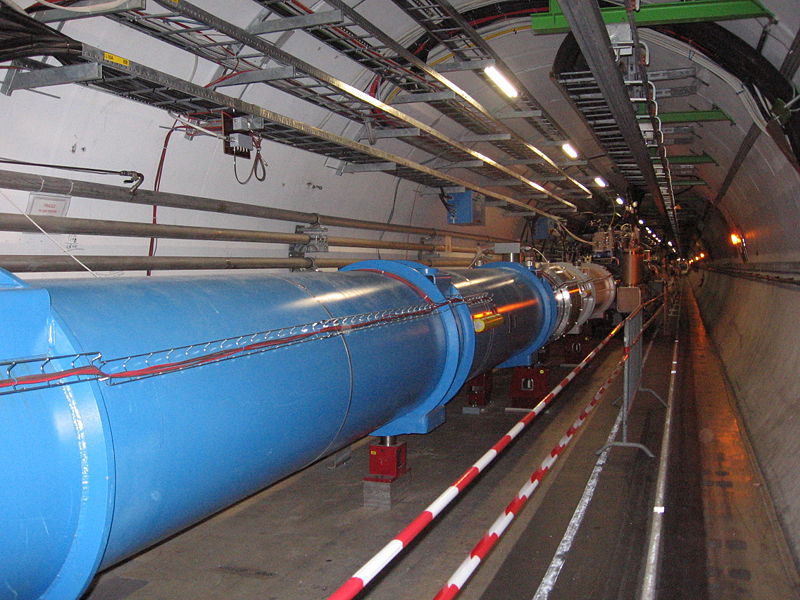 |
| The beam pipe surrounded with a magnet © Julian Herzogeigene |
Chris - When you want to build something on the scale of the LHC what are the sorts of engineering constraints there? How do you go about doing this?
Guy - First of all to be able to make a beam circulate round the LHC you need a vacuum pipe. Inside the vacuum pipe you need an ultra high vacuum. The vacuum of the LHC is about 20 times lower than the pressure on the surface of the moon. Once you have a beam circulating you need to keep it on its circular trajectory using very strong magnets. We have our two main kinds of magnets in the LHC: dipolar or two pole magnets which keep the beam on its trajectory round the ring; and quadrupole magnets which focus the very intense beams of protons to keep them inside the aperture of the vacuum pipe. The fields inside these dipole and quadrupole magnets are so high: about 170,000 times the Earth's magnetic field that we need to resort to superconducting technology to make these magnets. The coils of the magnets are made of a special alloy called niobium titanium. If you reduce the temperature of these coils down to very low temperatures, you're talking -270 degrees Celsius; the coil will conduct electricity with zero resistance. That way we can pass huge currents that are almost 12,000 amperes through the coil and produce these very powerful magnetic fields to keep the beam under control.
Helen - We actually had a question from Joshua on our forum which was about the temperature. He wanted to know why was it they needed to be kept so cold. It's nearly absolute zero, isn't it? How do you keep it so cold as well?
Guy - In fact we have a huge cryogenic refrigeration plant to cool down the whole machine. We need to use liquid helium to keep the magnets cold. The first stage of this process is to pre-cool the gaseous Helium using liquid nitrogen which is very cheap. We don't need huge quantities of liquid nitrogen. That will bring the temperature down to about 80 degrees Kelvin: something like -200 Celsius. Then we use cryogenic refrigeration plants to reduce the temperature down to the boiling point of helium. Now we're getting down to about four 4 degrees Kelvin. This is still not cold enough for the fields required for the currents that we require inside the LHC. We have further cold compressors, refrigeration plants which reduce the pressure in the Helium to 150 millibars. At this point the temperature reduces to 1.9 Kelvin which the operating temperature.
Chris - That's really quite cold, isn't it?
Guy - Colder than outer space, in fact.
Chris - Colder than Pluto, that's for sure! One last question, Guy: at this time of rising energy bills, what is your electricity bill?
Guy - In fact, the energy consumption of the LHC is similar to the whole of the city of Geneva (domestic consumption). Let me see, this is about 120 megawatts of power so -
Chris - Roughly how many households are there in Geneva?
Guy - There's roughly 150,000 households in Geneva.
Chris - That's quite a lot of energy, isn't it? But it's all for a good cause!
Guy - Yes!

40:12 - Using the LHC in Research
Using the LHC in Research
with Tara Shears from the University of Liverpool
Chris - Dr Tara Shears is from the University of Liverpool and she works on the [LHC]b detector. She's looking for antimatter. Tara, thank you for joining us on the Naked Scientists. Tell us a bit about your work.
Tara - My experiment LHCb was designed to look into the question of why, when we think the universe started in equal mixture of matter and antimatter, why there only seems to be one type: matter, around today. We think this inequality arose some time very early in the Universe's history - sometime in the first minute even. We don't know why it should be. We don't know why that happened. We think it's due to some difference in the behaviour of matter and antimatter but we're not quite sure what.
Chris - So what you're saying is there's basically two types of stuff. There's matter and antimatter. This will be like the North and South Pole of a magnet. What we see in the Universe at the moment is all the North Poles, begging the question of, 'Where have all the South Poles gone?'
Tara - That's exactly right. Antimatter's really, in a sense, like the mirror reflection of ordinary matter. We can find out whether it's present anywhere because one particular peculiarity that antimatter has is that whenever it meets normal matter it annihilates. It's quite dramatic. If you have a gram of matter meeting a gram of antimatter you get an explosion equivalent to about 5 kilotons of TNT.
Chris - So you can actually make antimatter?
Tara - You can generate antimatter at CERN in very, very small amounts. What happens at the LHC is that when we have the beam collisions, the proton-proton collisions, as Ben [Allanach]'s already told you we convert the energy of those beams into new particles. Some of those new particles will be antimatter particles.
Chris - So they're made of the same building blocks as matter particles them?
Tara - That's right. To give you an example, for every quark we have an antimatter quark equivalent. For something like the electron there's an antimatter equivalent that we call a positron. Every particle that we know about in the universe also has its antimatter equivalent.
Chris - How can we turn matter into antimatter, though?
Tara - What happens in the LHC is in the collision we either generate matter in the form of matter or antimatter, if that makes sense. It comes in one variety or the other. What we detect in our experiments is maybe the decay products of those particles (they don't live for very long) and what those particles decay to and identifying them we can infer whether we had a fundamental particle in the first place that was matter or antimatter.
Chris - You're starting with a beam of protons. These are matter protons though, aren't they? If you can make antimatter using those does that argue they're made of the same thing as antimatter?
Tara - Not at all because you've got to think that when we have this beam collision we have a certain amount of energy. Whatever collides in those protons (and like Ben said it's like swishing two wet rags together or two squidgy oranges) only part of the proton collides with each other. That converts to pure energy and if we apply Einstein's equation to mass, to particles, antimatter particles have the same mass as normal particles. In that respect these collisions - it doesn't really matter what's colliding together. You have this annihilation of energy and then that energy can be distributed into different particles. It doesn't matter whether it's matter or antimatter.
Chris - And then presumably this will give us insights into the nature of antimatter so we can understand perhaps how they use it.
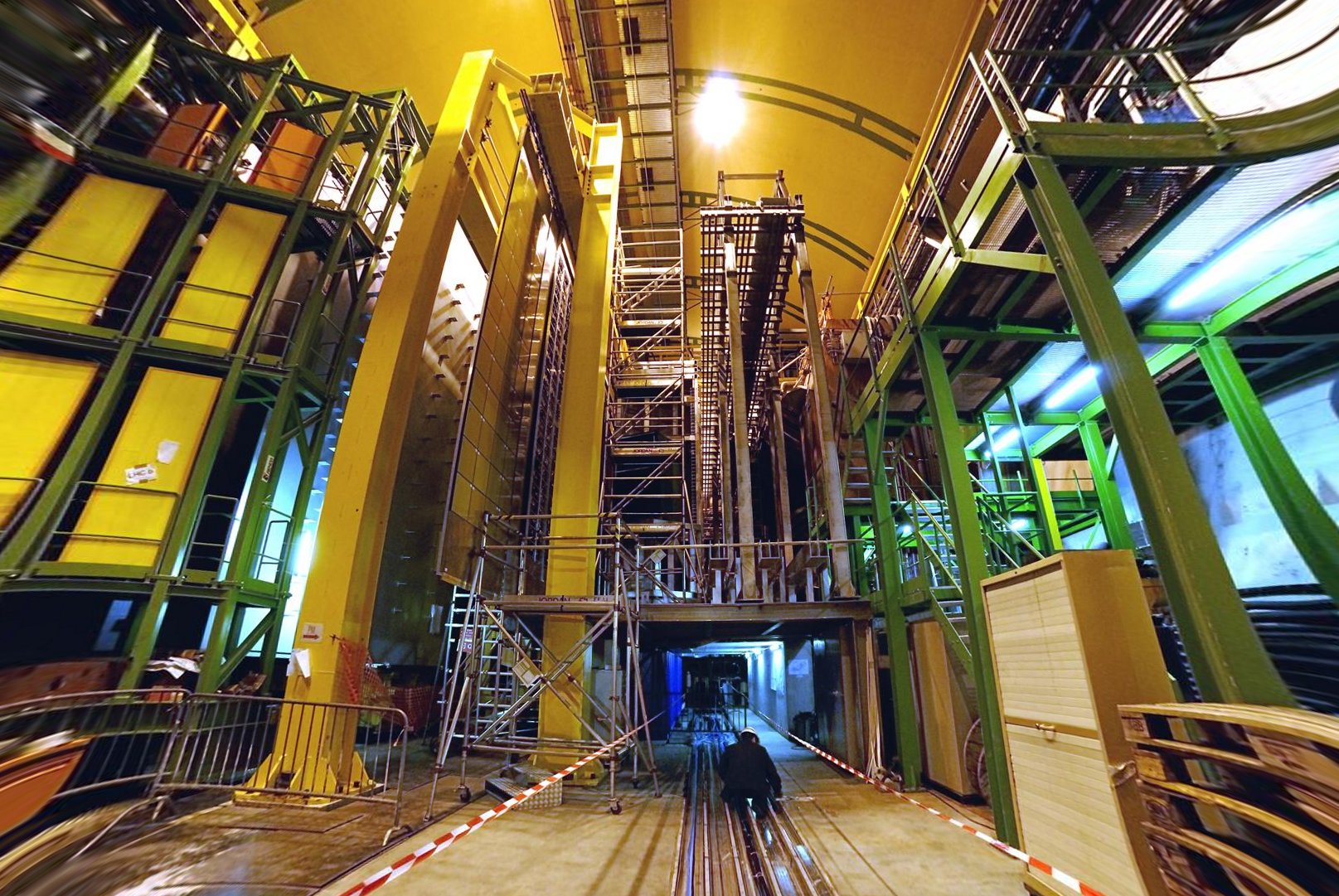 |
| A view inside the LHCb cavern © CERN |
Tara - That's what we're hoping with the LHCb experiment. We're hoping to get a better handle on the behaviour of antimatter as opposed to ordinary matter. We think there must have been some difference to give rise to this asymmetry which has allowed our universe to exist in the one state today.
Chris - Where do you think all the antimatter has gone? Is it just all jostled somewhere or is it in some other dimension that we can't see?
Tara - That's the $100,000,000 question, isn't it? I wish I knew the answer to that. We don't know basically. That's why we built the experiment. That's why we're doing our research. We don't know if there's some peculiarity in the behaviour of antimatter which means that it decays more quickly than normal matter. That's why it all seems to die out more quickly in the known universe. There are theories around that I don't even pretend to understand which say we could have antimatter in alternative, parallel universes. That's where it all went and we just happen to be in a parallel universe where there's only matter. There are many hypotheses but little experimental evidence to pin down the explanation.
44:53 - Can my brain become too full?
Can my brain become too full?
Answered by Professor Ian McLaren, University of Exeter
You asked if the brain overwrites old information each time I learn something new. The answer is when you learn new things you do forget the older stuff to some extent but it's not as bad as it sounds. Say you learn a list of metals and flower names. Then afterwards you learn a list of trees and plants. Learning that second list will make your memory for the first worse. We don't think it overwrites it. If I now tell you that that first list was metals and flower names and you use those cues, things you'd apparently forgotten resurface. It seems like they were harder to retrieve and we think that inaccessibility protects them, actually from being overwritten. If you didn't protect it in that way it would get overwritten and you really would lose stuff. The other question was, 'Is all this learning good for me or should I concentrate on learning less?' The problem as we age with our memories seems to be not a lack of capacity but we get worse at using it. We're not as good at controlling it. If you keep on learning things and using your memory a great deal, that can only help. It's a use-it-or-lose-it kind of idea. Hope that helps!
What is the grid?
Tara: The grid is like the next step up from the World Wide Web, if you like. Just as anybody with the computer and internet access can share information on the web so particle physicists can plug all their computers together. They have internet access and some special software that makes them all work together and come up with a distributed supercomputer that not only shares information but also the computing power of all the computers they have together. If you consider how big our experiments are, about 2000 people from 80 countries typically in the case of ATLAS. If all these institutions share their computers then they effectively make a supercomputer which is powerful enough to analyse the huge amounts of data that we need to analyse from the LHC to make our discoveries.
Why are planets, stars and subatomic particles round?
Ben: Everything isn't round. Admittedly planets and stars and things are and a bubble of soap that you blow is as well. That's essentially because tension pulls everything in and tends to make it spherical. If you're talking about fundamental particles they're not. When you see representations in a text book you'll have a little round ball. That's not what they're like. They're actually really weird. They travel as if they're a wave. They get absorbed as if they're a dot. It's not really like a sphere and you're talking about what's happening at very small distance scales with quantum physics. Chris: There was a paper in Nature recently where scientists were able to visualise hydrogen atoms with a stream of electrons. They were round balls. Ben: yes, so a hydrogen atom isn't fundamental. It's made of a core and something orbiting round the edge. It's a bit like a solar system and that does go round in a circle. There's a force and it reaches equilibrium just like the Earth goes around the sun. It's the same kind of picture. Chris: What about the tiny bits inside? How do you know what shape they are?
Ben: You don't they're dots, they're weird, they're fuzzy and they're quantum.
Related Content
- Previous Repelling Pests!
- Next Freezing Time and The Expanding Universe











Comments
Add a comment